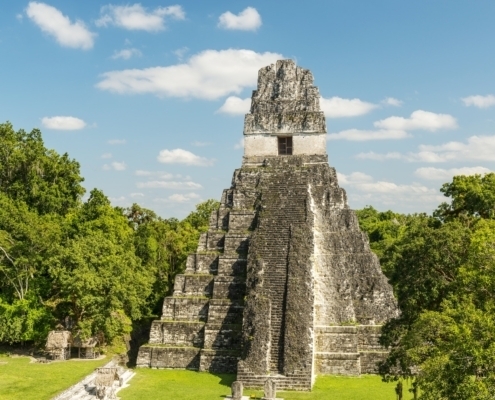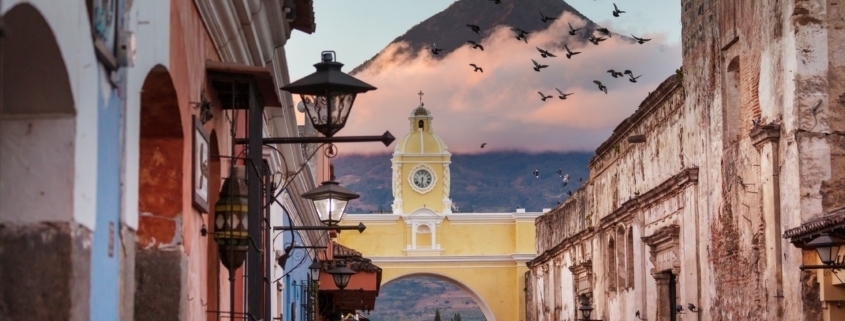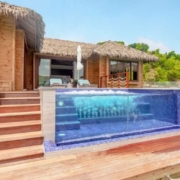Family Travel: Guatemala Adventure
It’s hot in Yaxhá, sweaty hot, jungle hot as we pause by the shores of a green lake to admire the bony backs and bulging eyes of a pair of crocodiles snoozing in the reeds near the shore. We pass the raised camping platforms, open to the air but covered with thatch to keep out the afternoon rains, frequent occurrences in El Petén, Guatemala’s humid lowlands.
Our guide motions us to keep walking along the dirt path thick with vines. At 1:00pm it’s too steamy even for the howler monkeys. Asleep now in the branches of the ramón trees, these agile climbers will wake the rain forest at first light with their throaty crescendo of screeches.
As we hike to the twittering of birds and the trilling of the cicadas, we’re beginning to sympathize with the cast of “Survivor” who trekked, schemed and camped at Yaxhá in hopes of winning $1 million.
Our goal is more modest, the East Acropolis where Temple 216 rises above the tall mahogany and gumbo limbo trees. Along the way we pass a ball court where the nobles played pok-ta-pok, a game in which they used their hips and thighs to bounce a ball off slanting walls in order to angle it through a suspended stone ring. At Yaxhá the stakes were high. The winners—not the losers—were sacrificed because, the guide explains, you give your best to the gods.

Tikal Jaguar Temple Guatemala
Since much of Yaxhá remains unexcavated, we walk by huge mounds covered with grasses and sprouting trees. Along the way we encounter just a handful of other visitors. That’s one of the bonuses of visiting this off-the-beaten path ceremonial site, unlike the better known Tikal, which like Yaxhá is also part of the 21,000-square km Maya Biosphere Reserve.
Tikal impresses us with its size– 222-square miles– and its scores of unearthed structures. Although the Maya populated this major city in 200 B.C., many of the excavated pyramids date to around 700 AD, part of the Classic period. Some archeologists estimate that at one time Tikal and its surrounding areas had a population nearing 100,000 people. Because of its vast acreage and the fact that it lies deep in the rainforest, Tikal, despite busloads of tourists, still retains a jungle-like feel. Palm, cedar, mahogany and other trees, many laced with twisty vines, line the pathways to the plazas. Spider monkeys jump from branch to branch and the occasional toucan careens onto a tree limb.
Standing in the Great Plaza, anchored by the Temple of the Jaguar and the Temple of the Masks, it’s easy for us to imagine nobles strutting through, talking politics and plotting war. The reward for climbing the steep staircase alongside Tikal’s tallest temple, the 230.98 foot high Temple IV is a panoramic view of the gray pyramid peaks rising from the thick, green forest canopy.
Another top Guatemalan site is Chichicastenango, dubbed “Chichi,” the country’s biggest native market. For more than 100-years, every Thursday and Sunday, about 300 Maya vendors from all parts of the country flock to the highland town to sell their goods. To get here twisting mountain roads take us through hamlets where fat pigs and feathery turkeys stand in the front yards of tin-roofed houses. Around a bend the view opens up to reveal a sweeping valley of apple orchards and cornfields hung low with clouds.

Guatemalan textile
It’s Wednesday night. A pick-up truck packed with families cuts in front of our van. Along the road Maya women wearing red and white huipiles, or tunics, hold the hands of their children as they walk towards Chichi.
As soon as we arrive at our hotel Victor Manuel Gonzalez greets us. A licensed guide, Victor, 12-years-old , has been escorting visitors through Chichi’s market for two years. With his father and older bother dead, Victor helps support his mother and sisters. He leads tourists during the day and attends school in the afternoon.
We follow Victor through the maze of wooden stalls the men hammer together for tomorrow’s market. The aroma of grilled chicken, fried potatoes and sweet plantains fills the air, punctuated by the quick slap-slap sound of women flattening tortillas between their palms. Three-wheeled motor taxis, called “tuk-tuks” after the sound of their horns, weave through the crowd, causing several thin, brown dogs to scurry out of the way.
On Thursday morning, before we browse the market, Victor first takes us to one of the morerías, a ceremonial mask workshop, where Ricardo Ignacio, 20-years-old and a fifth generation carver, patiently whittles a wooden horned creation for a ceremonial dance. Next, we follow a dirt path up a hill. At the summit a shaman with a weathered face lights candles on an altar and kneels in front of Pascual Abaj, a smoke blackened rock that’s the only shrine in all of Guatemala to the Mayan earth god. A couple, asking for prosperity for his new job, has brought incense, chocolate, sugar and pastries as an offering to the god. The gray smoke of the incense floats in front of the praying shaman, adding a scrim of other-worldiness.
Unlike the quiet on the hilltop, back in town the market is thick with people. Women with stacks of woven tablecloths balanced on their heads elbow through the crowds. Men carry cargo-sized bundles on their backs.
Trios of little girls shove fistfuls of beaded necklaces toward us. Vendors stand in front of their stalls, beckoning us to look.
Chichi is not for everyone, only for those who like local markets and get an adrenaline rush from bargaining. Buyers for some big department stores come to Chichi to purchase handmade floral wall hangings, embroidered tablecloths, woven rugs, placemats, throw pillows, leather belts and carry-on bags, many of which sell stateside for five to ten times the local price.
When we pause at a stall to finger a blue table runner decorated with green, purple and yellow native designs, a group of Maya women gather behind us. As soon as we step away from the booth, the women unfurl more runners, saying “Buy from me, lady. Buy from me.” Another woman steps in front of us, her arm draped with multi-colored scarves. Although we repeatedly say, “No, thank you,” she follows us up and down the narrow aisles and even into the locals’ section where Maya women sell live chickens out of burlap sacks. Eventually, after much browsing and bargaining, we give in and purchase two scarves from our follower as well as, from others, placemats, a painted ceramic necklace and several colorful huipiles.
The craft market is less intense in Antigua, the former colonial capital about a 45 minute drive from Guatemala City. Although shoppers come here for the jadeite rings, bracelets, necklaces and even masks sold in stores, the city gains fame as one of Central America’s prettiest. It has cobblestone streets, colonial churches, yellow, ochre and pink buildings, and an inviting town square crowned by a mermaid water fountain and shaded by African tulip and feathery jacaranda trees.
The Iglesia de San Francisco has the tomb of Central America’s first saint, Hermano Pedro de San José de Betancourt, who came to Guatemala in 1651 from Spain and established hospitals and services for the poor. Inside the church a small museum displays his tattered cape and hat. Photos, leg braces and crutches sent by the healed who prayed to the saint for help line the walls of a hallway. At his tomb, the hopeful pray, including women in Maya dress. The supplicants hold wax candles shaped like hearts, legs or other body parts they wish to heal.
An area that is healing itself and rebuilding is Lake Atitlan, ranked as one of the world’s most scenic lakes. One of Guatemala’s largest lakes, Lake Atitlan spreads out against a backdrop of three 10,000-foot volcanoes – Toliman, Atitlan and San Pedro. Unfortunately, in October 2005 Hurricane Stan drenched Guatemala causing mudslides in this area. Several Maya settlements were so thickly covered that rescuers gave up and officials designated the buried villages as cemeteries.

Lake Atitlan Shoreline
Although the mud reached Panajachel, the gateway to Lake Atitlan as well as Santiago Atitlan, one of the bigger lakeside villages, Guatemalans are digging out. At this writing, many of the small tourist hotels around the lake are once again accepting guests.
Guatemala is a memorable trip. The towering pyramids of ancient Tikal inspire awe, the rain forest thrums with the crescendo of howler monkeys, and the country’s Maya villages prove that these people, far from being extinct, have a vital culture.
Accommodations
Guatemala is affordable. Rooms in top rated hotels in Guatemala City range from $140-$220 per night while comfortable lodgings in small towns range from $70-$120 per night, often with breakfast included.
Guatemala City: The Quinta Real Guatemala offers upscale rooms and service. (502) 2420-7720. Rooms from $140. www.quintareal.com.gt.
Antigua: Casa Santo Domingo, a converted convent elegantly blending Spanish traditional furnishings with modern comforts, has gardens, pools and good food. Rooms from $110 double. Meals extra. (502) 7820-1220. www.casasantodomingo.com.gt.
Chichi: Hotel Santo Tomas has a Spanish colonial feel, swimming pool and rates from $76 for two with breakfast. (502) 7756-1061
Near Tikal: Camino Real Tikal, Lake Peten Itza, has a pool, comfortable rooms and rates from $110 for two. Meals extra. (502) 7926-0204. www.caminorealtikal.com.gt
Lake Atitlan: Casa Palopó is a charming, boutique hotel on the shores of the lake. Rooms from $120 double. Meals extra.
(502) 762-2270.
www.casapalopo.com


 Antigua Royalton
Antigua Royalton Travel Tips and Trips
Travel Tips and Trips
 Frommers.com
Frommers.com Washington Times
Washington Times Continental Magazine
Continental Magazine BellaOnline.com
BellaOnline.com Continental Magazine
Continental Magazine